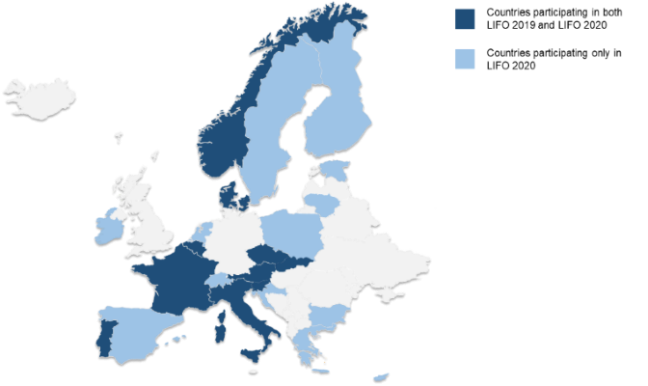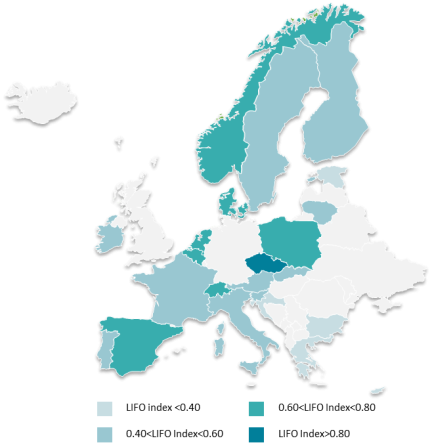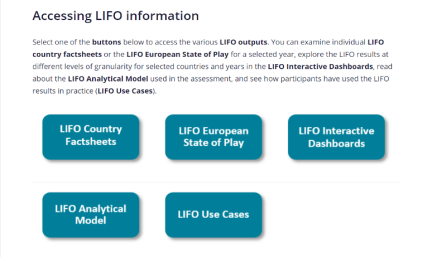
The Location Interoperability Framework Observatory (LIFO) monitors the implementation of location data interoperability good practices in European public administrations, based on the level of adoption of recommendations in the EULF Blueprint. It has now completed its second run, after a first one in 2019.
The information collected through LIFO can be used in the analysis of location interoperability throughout Europe by:
- examining current national and European status;
- comparing countries;
- identifying strengths and areas needing improvement;
- uncovering best practice solutions.
Speakers at the event, moderated by Simon Vrečar, external consultant at the European 'Commission's Joint Research Centre (JRC), were Ray Boguslawski, external consultant at the European 'Commission's Joint Research Centre (JRC) and Massimo Pedroli, senior consultant in the public sector at Deloitte.
EULF Blueprint and LIFO



Examples of primary indicators used in the LIFO analytical model include:
- Datasets and means of access relating to the Open Data Directive
- GDPR readiness
- Standards applied
- Use of INSPIRE datasets
Examples of secondary indicators used in the LIFO analytical model include:
- Datasets and means of access under the INSPIRE Directive
- Policies on reuse of public sector information by the private sector
LIFO 2020 results
Massimo Pedroli showcased insights from the 23 country factsheets and the comprehensive European State of Play report.

The countries participating in both years have improved their positioning in all five focus areas. The improvements range from quite considerable in the Policy and Strategy Alignment focus area to only marginal in the Digital Government Integration focus area. Still, the overall difference is significant, also considering the other three focus areas.
- The combined LIFO index for the 23 countries is 0.55, which confirms an average good level of maturity for the participants;
- The Policy and Strategy Alignment focus area has the highest score of 0.63, followed by Return on Investment (0.58), Digital Government Integration (0.57) and Standardisation and Reuse (0.55); the Governance, Partnerships and Capabilities focus area stands apart with the lowest score (0.45);
- A group of four outliers (Czech Republic, Belgium, Norway and Denmark) have reported excellent scores in all focus areas; five more countries (Poland, Switzerland, The Netherlands, Spain, France and Sweden) are positioned above the average; the remaining countries (more than half of the total) have more or less significant room for improvement;
- Even with the diverse levels of maturity across all focus areas, and in each of them separately, all countries have offered some examples of best practices in one or more focus areas.
LIFO resources

The webinar included a walkthrough of the LIFO Interactive Dashboards, a set of interactive tools enabling users to navigate through a series of charts displaying the level of implementation of the EULF Blueprint in participating countries at four different levels of aggregation:
- LIFO Index
- Focus Areas
- Recommendations
- Indicators

A summary was given of Case Studies based on interviews with representatives of four countries (Czech Republic, Italy, Norway and Slovenia) which offers an assessment of the current and prospective use of LIFO under four dimensions (added value of the LIFO process for location interoperability, LIFO online tools, use of LIFO results and outreach).
In conclusion, Massimo Pedroli showcased how users can build their user journey to exploit LIFO resources together with the LIFO Blueprint. The webinar presented the case of a policymaker who wants to explore what actions to take to improve policymaking through better use of location information. The policymaker can consult the country results on the factsheet and the dashboards to identify areas for improvement in relevant focus areas, recommendations and indicators. He can consider applying best practices from other countries in the country factsheets, the European State of Play and the EULF Blueprint. The policymaker can also use the LIFO model to carry out self-assessments at a specific level (e.g. organisation, locality, policy area) and plan improvement actions. Finally, measurements of progress using the LIFO analytical model and/or the dashboards for self-assessment can be made to share outcomes of the process, discuss approaches for improvement and ask for advice from the ELISE community in Joinup by opening a discussion.
Main outcomes from Q & A session
At the end of the presentation, the audience participated in an active discussion. Contributors highlighted the importance of exploiting the opportunity offered by LIFO to compare results from the LIFO dashboard and examine initiatives in different countries in the view of the interconnected geospatial world, as well as to consider the EULF Blueprint and the LIFO Analytical Framework.
Following the strategic recommendations on location interoperability highlighted during the webinar, a participant stressed the significant progress made in geospatial awareness and capacity building while pointing out the need to go further along this path.
The audience recommended exploring a more automated approach to LIFO data collection, further exploiting secondary sources. The latter would optimise the process and enhance the opportunity to rely on certified data.
LIFO also offers the opportunity to streamline the communication and coordination between different sectors, data providers and digital service users. This positive outcome can be strengthened by leveraging guidance documents such as the EULF Blueprint and orientation activities.
A participant remarked that a good positioning in LIFO comes from a long process carried out in recent years to face the administrative and economic changes that influenced the quality of location data. The high number of inconsistencies and the frequent changes encountered in the past have highlighted how critical location information is to steer public administration reform to improve the quality of public digital services.
Slides and Recording
Check out the recording and supporting slides of the session.
If you are interested in knowing more about ELISE Webinars you can find further information here.

